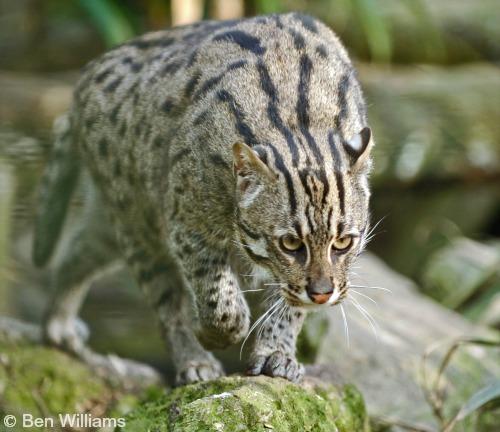
- HB Length: 57-115 cm (22-45″)
- Tail Length: 24-40 cm (9-16″)
- Height: 38-40 cm (15-16″)
- Weight: 5-16 kg (11-35 lbs)
- Pop. Trend: Decreasing
Larger than a domestic cat, the Fishing Cat Prionailurus viverrinus is well adapted to catching fish, its primary prey. They have a deep-chested body with short legs, a big, broad head, and a short tail. The short, coarse fur is a grizzled grey in colour, and tinged with brown. There are elongated dark brown spots arranged in longitudinal rows extending over the entire body. There are six to eight dark lines running from the forehead to the neck, and the underparts are whitish and spotted. The head is relatively big and broad, the muzzle somewhat elongated. Their eyes have greenish irises, and the ears are rather short and rounded, with black on the back and prominent white spots in the middle. The legs are short with the forelimbs having two distinct elbow bars. The tail is less than half the head and body length, is relatively thick, and has a series of incomplete rings with a black tip.
Their front feet are partially webbed and their claw tips protrude from their sheaths even when retracted, leaving a signature track imprint.
One remarkable feature is the layered structure of their fur, a crucial adaptation to life in the water. Next to the skin lies a layer of short hair so dense that water cannot penetrate it. Like snug-fitting thermal underwear, this coat helps keep the animal warm and dry even during chilly fishing expeditions. Sprouting up through the first coat is another layer of long guard hairs which gives the cat its pattern and glossy sheen.
Distribution

Fishing Cats have a discontinuous distribution in South East Asia, northern India and Sri Lanka. Research on the fishing cat began only in 2009, but it is already believed to be extinct in Vietnam and on the island of Java; meanwhile, there are no confirmed records in Laos PDR and scarce information from Myanmar and Thailand. However, one survey has confirmed that a population survives in southwest Cambodia’s Peam Krasop Wildlife Sanctuary (PKWS) — one of only two locations in Cambodia where the fishing cat has been recorded since 2003.
Although they are thought to occur on Sumatra, there are no definite historic records, recent records have been shown to be erroneous, and its presence there remains to be confirmed. Fishing cats are widely distributed but concentrated primarily in wetland habitats, which are increasingly being settled, degraded and converted.
These cats are typically found in a number of water habitats, including marshy thickets, mangrove swamps, and densely vegetated areas along rivers and streams. They have been recorded at elevations up to 1,525 metres in the Indian Himalayas where they frequent dense vegetation near rivers and streams. They have also been observed in degraded habitat such as near aquaculture ponds.
A study on the island of Java found that Fishing Cats inhabit coastal wetlands less than 15 km from the ocean, no higher than 20 metres above sea level. Another radio telemetry study in a Nepal national park found Fishing Cats were active only at night, and spent most of their time in dense grassland, sometimes away from water. Home ranges of three females were 4-6 km2, and that of a single male was 16-22 km2.
Their presence in Cambodia was only confirmed in 2009, and their distribution in that country is poorly known. The identification of Fishing Cats there is difficult, due to their resemblance to the large geographical size variations of the Leopard Cat Prionailurus bengalensis. Juveniles of the two species are visually very similar.
Ecology
Fishing Cats are another feline that contradicts the belief that cats don’t like water. They are strong swimmers, and can cover long distances underwater. They have been seen wading and swimming in shallow water, hunting for a variety of aquatic prey. They often hunt for fish while fully immersed in water, and have been seen catching fish by plunging their heads under water, and flicking or scooping them out with their paws. One report describes them catching waterfowl by swimming underwater and seizing their legs from beneath.
A one year study of scat analysis in India revealed that 76% of their food was fish, with some birds, insects and rodents also taken. Grass was present in the diet in all months except August, during the monsoon season.
Fishing Cats are capable of taking large mammal prey, and have been seen scavenging livestock carcasses and Tiger Panthera tigris kills. They are thought to be primarily nocturnal but little is known of their behaviour in the wild.
Reproduction
These cats are assumed to be polyestrous year round. They are said to have a characteristic mating call, but the call has not been described. Dens are constructed in dense shrubbery, reeds, hollow trees, in rocky crevices, or in other secluded locations. Kittens have been seen in the wild in April and June, and have been born at the Philadelphia Zoo in March and August. One to four, usually two, kittens are born after a 63 – 70 day gestation, and weigh around 170 grams at birth. Their eyes are open by 16 days, meat is taken around 53 days, and the kittens are weaned between four and six months. Adult size is attained at eight to nine months, and the young are independent between 12 – 18 months. It is thought that in the wild the adult male may help with the care and supervision of the young, but this is unverified. Captive individuals have lived to 12 years of age.
Conservation
According to the IUCN Red List assessment, the cat’s numbers globally have declined by over 30 percent in the last 15 years, but nowhere is the rate more alarming than in Southeast Asia, where the greatest threat to the cat’s survival is human persecution.
Wetland destruction is also a threat facing this species, as over 50% of Asian wetlands are under threat and disappearing. Indiscriminate trapping, snaring and poisoning are also taking a toll. Fishing Cats are considered a food item in many areas of their range, and are also persecuted for taking domestic stock.
A long-term study in Thailand found 9 of their 17 radio-collared cats had disappeared or been killed by poachers. Working with government officials, the researchers have had the Fishing Cat made part of the provincial natural resources protection policy, and an extensive public awareness conservation campaign is underway.
Read more about the Leopard Cat, a species that is often confused with the Fishing Cat in the wild.
Range map IUCN Red List (2008)
Updated 2018

Emily
Their call sounds like a low, gravelly bleat https://www.youtube.com/watch?v=xjBmEMI9jJo
Pat Bumstead
No, sorry. There is no information on that for any small wild cat species.
Ethan
Do you have a “population summary” or something like that which shows the history of the population?
Pat Bumstead
None that we are aware of but scientists are still just learning about the lives of these cats.
cathy smith
are there any symbiotic relashonships that the fishing cat has?
Pat Bumstead
As with all wildlife species today, the best way to prevent the extinction of the fishing cat is to save their habitat. Fishing cats need a very specific type of area to live in, with lots of water. These are also the areas humans are interested in developing so their habitat is disappearing very rapidly.
Aman Hooda
What are the ways to prevent extinction of fishing cat
Pat Bumstead
No one knows how many Fishing Cats there are. They live in thick forest in a large number of countries, and it would be impossible to count them.
Daniel
What is the fishinh cat population over the past 10 years?